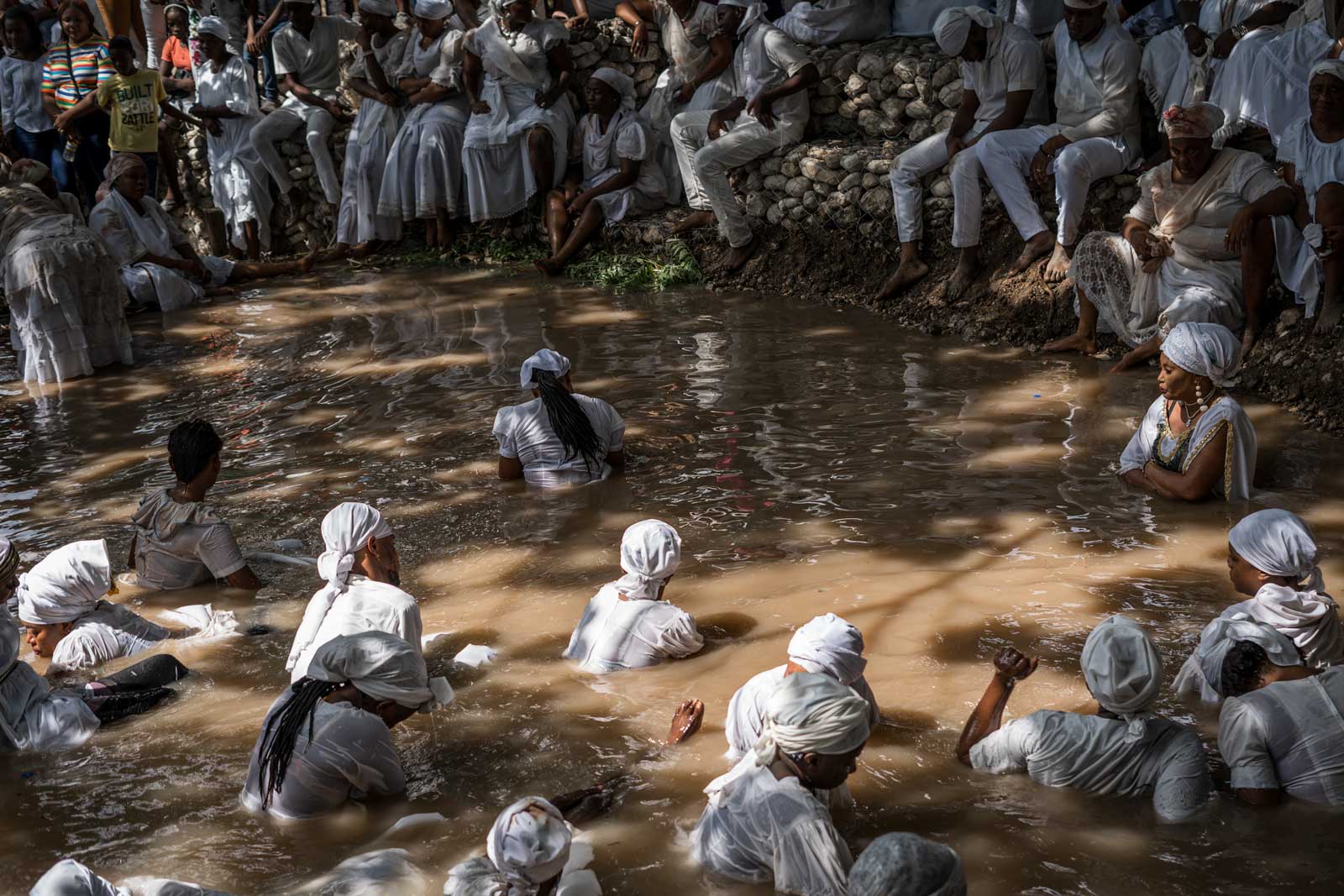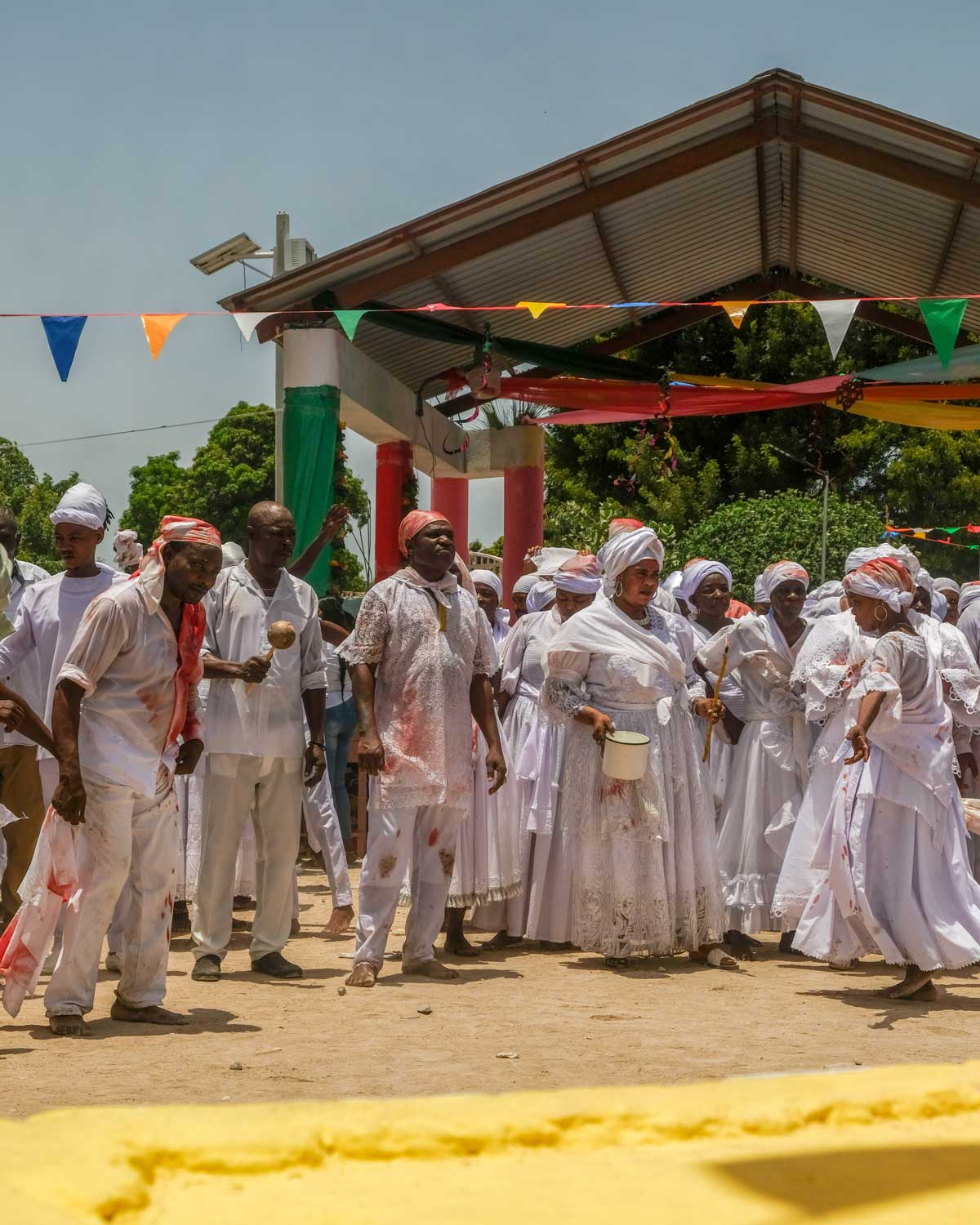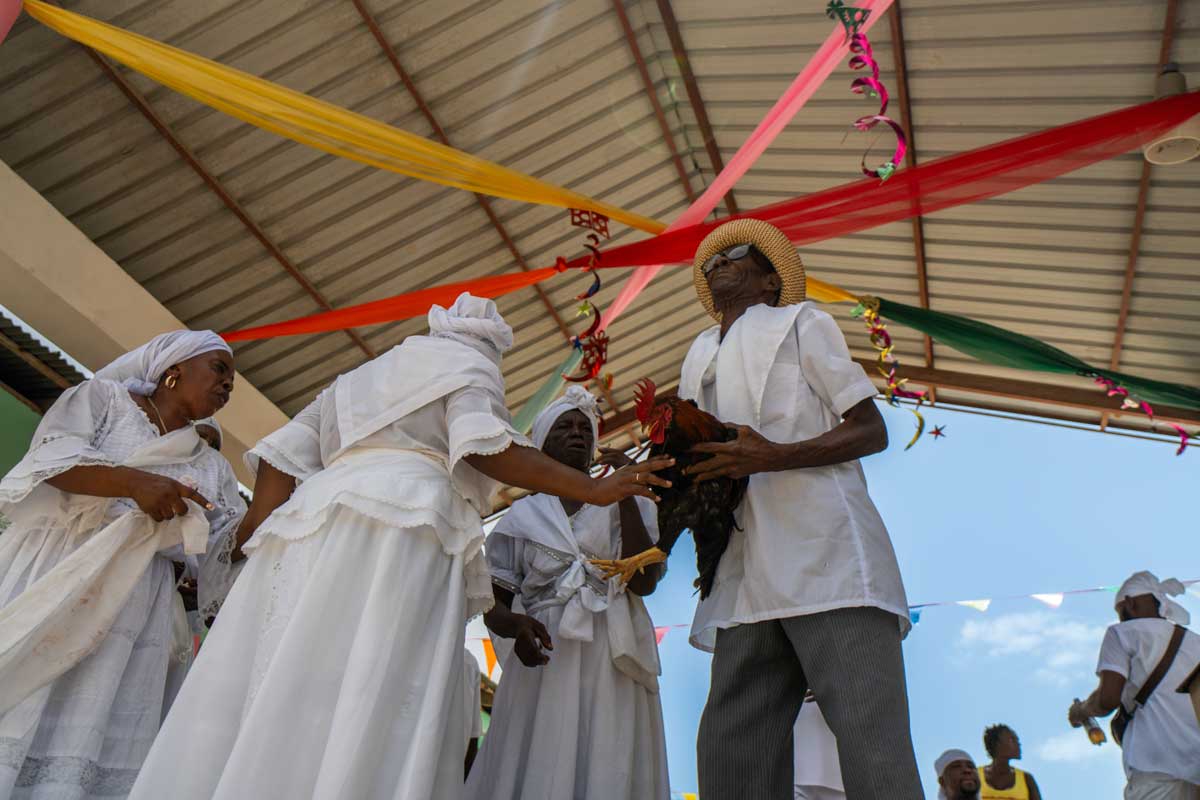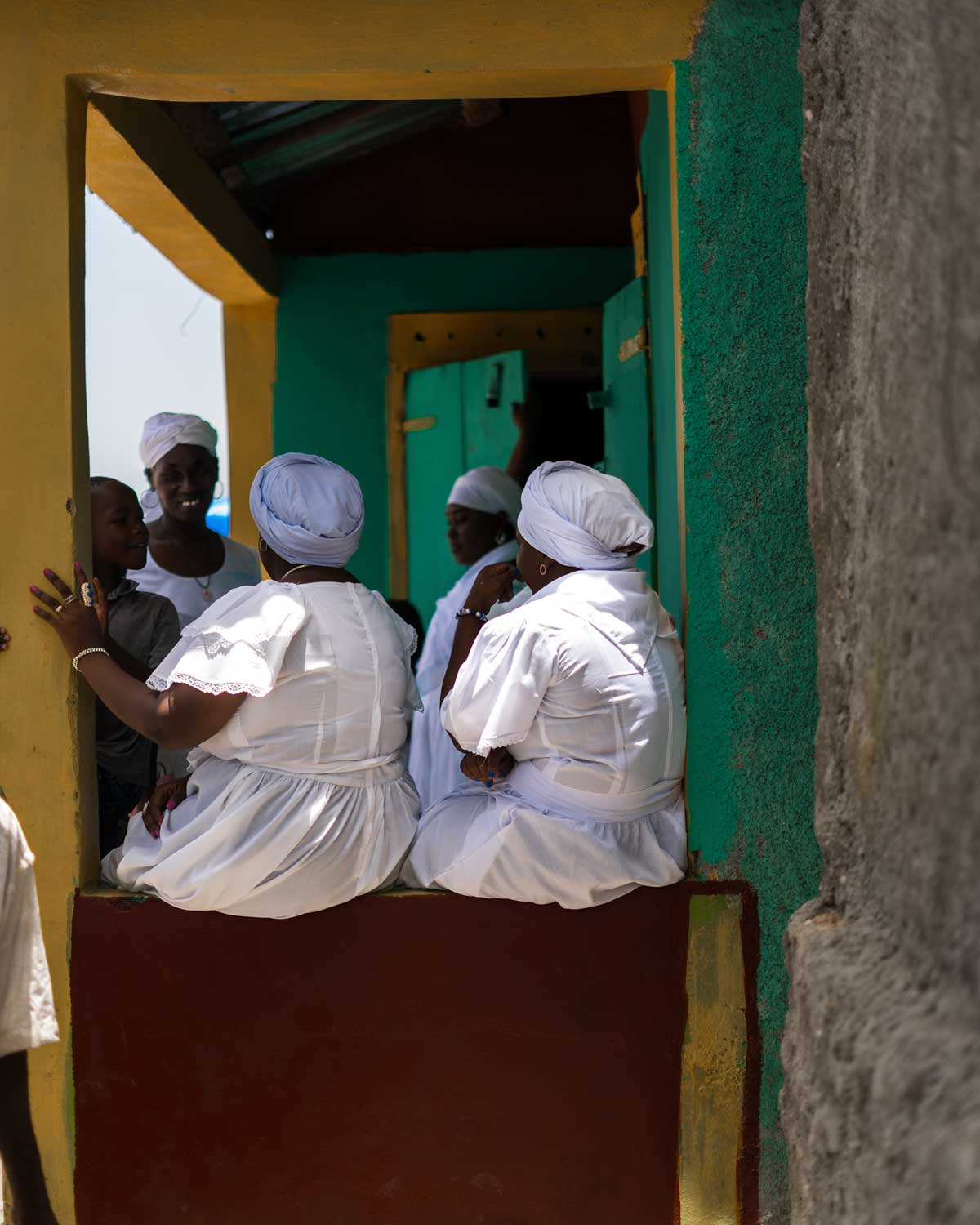
Photo: Jean Oscar Augustin
Rhythms and Rituals at Lakou Soukri’s Vodou Festival
Dive into the heart of Haiti with a journey to Lakou Soukri’s annual Vodou Festival, where tradition, spirituality, and community come to life
Located deep in Haiti’s Artibonite Department, Lakou Soukri annually emerges as the epicenter of a festival deeply rooted in Vodou culture, renowned for its spiritual significance and sense of community.
Despite its rich traditions, Vodou frequently encounters misunderstandings and stereotypes that veil its authenticity.
What essential truths does Lakou Soukri’s festival reveal about Vodou?
Our visit to the Lakou aimed to uncover the heart of the festival, drawing us into a celebration marked by dance, offerings, and communal spirit. This journey through the festival showcases Vodou steeped in tradition, devotion, and a deep bond with the natural and spiritual realms, transcending widespread misconceptions.

Photo: Jean Oscar Augustin
What is a lakou?
In the heart of Haitian cultural traditions lies the lakou, more than just a space, it’s a cornerstone of community and spirituality. Long before cities, neighborhoods, and municipalities, there were lakou. This social organization resembles the communal essence of African villages, serving as a nurturing ground for education, devotion, and the preservation of Vodou traditions. Central to each lakou is the poto mitan, a symbolic pillar connecting the community to their ancestors and the spiritual world.
Leadership within a lakou comes from the Houngan (Vodou priest) or Mambo (Vodou priestess), who are not only spiritual guides but also serve as healers and community organizers. Their role is critical in maintaining the social fabric and spiritual health of their community, whether they’re natives or newly initiated members.
One notable lakou, Soukri Danach, stands out for its historical significance and its annual festival that attracts a diverse crowd. This event embodies the communal and spiritual vitality of the lakou, highlighting its role in Haitian society.
The Ancient Echoes of Lakou Soukri Danache
Lakou Soukri Danache is a beacon among Haiti’s spiritual landscapes, heralded as one of three pivotal spiritual sites. Its roots are said to stretch back before Haiti’s own emergence as a nation, entwining with the histories of Lakou Souvenance and Badjo to form a sacred trinity, each guardian to a unique Vodou rite. Soukri, in particular, vibrates with the Congo rite, a living homage to the ancestral traditions of Congolese slaves, in contrast to Souvenance’s alignment with the Dahomey kingdom rites of Benin.
The lore of its inception ties back to Zinzin Figaro, revered as the first to lead the lakou. Soukri’s history is rich with tales of refuge for maroon slaves from Congo, seeking solace and freedom in the heart of Haiti’s struggle for independence.
Sprawling across two and a half hectares, Soukri Danache is a tapestry of dwellings, plantations, and families, thriving on agriculture and livestock yet bound by a profound spiritual legacy. Annually, this lakou calls back its children, those born within and those initiated under its shade, in a pilgrimage that reaffirms the unbroken connection to their spiritual and cultural heritage.

Photo: Jean Oscar Augustin
Sacred Rituals & Soulful Gatherings
Embraced by the call to return, the children of Lakou Soukri converge to celebrate their rich heritage in a festival that spans over two weeks. During this period, the lakou is brimming with activities that touch the essence of Vodou: from rhythmic dance to solemnity of ceremonies, offerings, and ritual baths.
As dusk settles on August 14th, the sacred grounds of the temple, known as Soba, come alive with anticipation. This night is reserved for Met Kafou, the Vodou loa (meaning Vodou spirit) seen as the custodian of crossroads, a symbol of choices, paths, and the intersections of life and the spiritual realm. The assembled, both initiated and intrigued, are led by figures of spiritual authority through the gates to the temple, engaging in prayers that seek blessings from the loas, reinforcing the bonds of unity and shared existence.
The crescendo arrives the day after, on August 15th, with a grand Vodou ceremony. Adorned in white, symbolizing purity and openness, participants gather at designated sanctuaries within the lakou. The day’s ceremonies begin with prayers, drumming, and ritual sacrifices — roosters by the gate, goats within the Soba, and a bull near an ancient tree known as Palan Ganga, each act deepening the spiritual ambiance.
If you find the idea of animal offerings unsettling, know that for believers, this is a ritual rooted in reciprocity and the maintenance of cosmic balance.

Photo: Jean Oscar Augustin
Following these poignant moments, attention shifts to the Basin Inan for a ritual bath honoring the loa Manbo Inan. Surrounded by towering trees, this natural pool witnesses a mesmerizing ceremony of intensive drumming, dancing, and singing, culminating when the loa, believed to dwell in these waters, materializes. The initiated, now in a state of possession, leap frantically into the pool in a display of faith and ecstasy.
This extraordinary scene not only offers a glimpse into the profound spirituality of Vodou but also allows pilgrims to seek blessings by collecting water from this sacred site.
The days that follow are filled with dances and ceremonies at various spirit resting places, each moment deepening the communal and spiritual connections. The festival concludes with a universal salutation to the cardinal points, a final act of unity and reverence, encapsulating the profound journey of return and celebration that is the Lakou Soukri festival.

Photo: Jean Oscar Augustin
When to Experience the Magic of Soukri
The enchanting Soukri festival unfolds annually from August 14th until the early days of September. This timeframe, bridging the warm summer and the onset of fall, creates an ideal setting for the night dances and sumptuous feasts characteristic of Vodou celebrations, all while avoiding the season’s heavy rains.
Getting there
The lakou is located a few kilometers north of Gonaïves. The simplest route is to take a tap-tap or a motorcycle taxi from the city, heading towards the locality of Mapou and then continuing towards Soukri. As you approach, remember the profound respect this lakou commands among its keepers, thus, approaching it with mindfulness and respect for its spiritual significance is essential.
Want to make an offering?
To immerse yourself in the festival’s spirit, consider bringing an offering. For specific guidance, an initiate can advise on what’s most appropriate for each ceremony. Commonly, a bottle of Haitian rum serves as a welcome gift. When you present this to the Lakou’s servant for the Loas’ table, it signifies your participation in a tradition of generosity. Witnessing this, you might also experience, as do the initiates and pilgrims, the profound generosity of the loas in return.
Written by Costaguinov Baptiste.
Published April 2024.
Explore the Mystical Side of Haiti

Paradise for your inbox
Your monthly ticket to Haiti awaits! Get first-hand travel tips, the latest news, and inspiring stories delivered straight to your inbox—no spam, just paradise.


